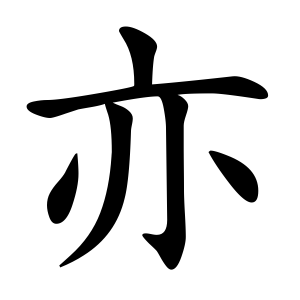亦
- also, too, likewise;
- moreover, in addition;
Etymology
Originally a pictographic character depicting a person standing with arms and legs spread wide (大), with dots at both armpits — representing the word “armpit.”
This early anatomical meaning later disappeared, while the abstract adverbial sense “also” emerged through semantic shift.
To distinguish the older “armpit” meaning, a new derivative character 腋 (겨드랑이 액) was later created by adding the 肉 (flesh radical) to 亦.
Thus, the evolution of 亦 → 腋 mirrors a classic example of semantic specialization in the Chinese script.
Usage in Korean
또 역 (亦) — also, too, likewise.
역시 (亦是) — also, indeed, as expected.
불역 (不亦) — “is it not also…?” — a common rhetorical pattern in Classical Chinese (cf. “不亦說乎” from The Analects).
Appears frequently in classical texts and proverbs as a connective adverb expressing emphasis, agreement, or addition.
Example:
學而時習之,不亦說乎 — “To learn and constantly practice what one has learned, is it not also a joy?” (Analects 1:1)
Words that derived from 亦
- 卜中弓金 (YLNC)
- ⿱ 亠 ⿻ 小 丿 (G T J K)
- ⿵ 六 ⿰ 丿 亅 (G T J K)
- ⿱ 亠 ⿻ 小 丨 (H)
- ⿵ 六 刂 (H)
